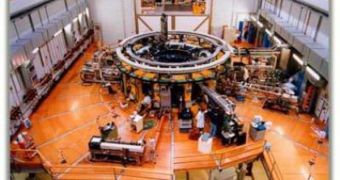Learning how to control a plasma flow is something that is absolutely essential in the field of nuclear-fusion research. At this point, physicists keep the stuff in place using magnetic confinement fields, but the method is worthless if the experts don't know what plasma can and cannot do, and also how it behaves under various temperatures and energy inputs. This basic research may have gotten a boost forward in a new study, conducted by scientists working with the large Reversed Field Pinch (RFP) fusion device RFX, in Padova, Italy.
When nuclear fusion research is conducted, the physicists need to have a consistent flow of plasma, without too many variations, and especially without peaks in temperature and sudden behavioral changes. In a magnetized plasma doughnut, increasing electrical-current flowing leads to significant kinking, which is a process similar to what happens when you keep twisting a straight elastic string. These extreme variations render attempts to use the stuff for furthering nuclear-fusion knowledge useless, so experts have been looking for a way of stamping that out for a long time.
Essentially, what needed to be done was to find a way of keeping the plasma helix stable and smooth. The Italian research group demonstrated that, by constantly increasing the electrical flow through the stuff, a smooth helix could be obtained at currents above 1.5 million amperes. A number of positive things happened when the current reached this threshold, including the fact that the magnetic fields began to trap the plasma better, as well as the fact that the plasma immediately got hotter, which is always good in nuclear fusion.
The new find also carries with it a number of innovations that could be used in the near future for creating cheaper and more effective nuclear-fusion power plants. For instance, the scientists noticed that, when the plasma was helical, so was the electrical current passing through it. This means that the length of the electrical circuit is considerably increased, the team reveals. At least in theory, reaching thermonuclear temperatures may become possible using only the currents that are dissipated in the plasma, which means that no additional heating or high-tech superconducting coils are needed.

 14 DAY TRIAL //
14 DAY TRIAL //